| Author: | | New Member Registered: February, 2019 Posts: 15 | | Review Date: November 7, 2023 | Recommended | Price: None indicated
| Rating: 9 |
| Pros: | Sharpness at infinity | | Cons: | Read the review | | Sharpness: 9
Aberrations: 9
Bokeh: 9
Handling: 6
Value: 5
Camera Used: Digital full frame and film
| |
Everyone should know that Helios copied the post WW2 Biotar lens design, so what's the difference? I have two mint black Helios 44-2 58mm lenses that I compared to my copy of the Biotar. One Helios is a KMZ lens (with the prism icon) and one is a Vladai made lens (with the Shish Kebab icon). Lots of online reviews like to praise the KMZ lenses for close focus effects, but I've never found any real differences.
The Biotar is the version that looks like the Helios 58mm 44-2 1970's/80's Biotar copy. The lens arrived looking mint, but it was a bit of a mess mechanically and optically. The Biotar has a very slightly 10% hazy rear article of glass but is otherwise mint. The focus was originally slower and lumpy due to Zeiss using such bad helicoid grease; a typical post-WW2 Zeiss thing. Aperture adjustment is still a bit rough and clunky, but was originally awful. Front lens fixture ring was originally stuck solid with the front glass full of dust and dry condensation around the internal edge. I had to drill two holes into the front rim to get it out with a lens wrench to clean the glass. The rear glass retaining mechanism is truly bad with ridiculous thin and delicate side anchor rings that cannot be got to and turned open without specialist tools. People talk about Zeiss design being widespread and wonderful but this rear system is truly bad.
The Biotar has no red letter to mark any fancy lens coating but it has the coating nevertheless. But some people do like to pay more for a red "T" or "R" on the rim - or whatever it is - as it makes them think their lens is special so they pay more for it. From the 1960's/70's if the lens has the "Transparent" coating you can see the blue/reddish/purple coating so you don't need a red letter on the front rim to tell you that your lens has it.
I'm not one to bother myself with assumptive talk about having 22 aperture blades in a lens or 12 or 8 or 6 as it's all stuff that people use to justify paying a fortune for pretty much no real difference in optical performance. The only real physical difference number make is rounder blobby bokeh and when a lens is wider open all apertures are pretty much round, or perfectly so
Close up and the Helios copies give better imaging at the edges at f2 and f2.8. Central sharpness is almost exactly the same with an acceptable level of softness with the Helios lenses. The Biotar is slightly sharper in the centre. Bokeh and swirl are pretty much equal with maybe the KMZ Helios looking a very tiny bit more dramatic. The Biotar starts to lead both the Helios lenses for central sharpness and overall quality at f4 and gets even finer in terms of central sharpness at f5.6 and f8.
Switch to 15 yard mid-distance to infinity. This is where many lenses show any weakness. Few online reviews bother about this all-important focal distance. As an aside, I do not normally offer any lens 9 or 10 out of 10 unless it deserves it. So how did the Biotar do? Here, the Biotar leaves the Helios pair standing. The Valdai Helios has always given me better mid to long distance image quality that is slightly sharper (about 8-9/10) than the KMZ (8/10) with the Valdai being slightly sharper at infinity. At f4 to f11 the Biotar is as equally superb at 9/10. And that's with 10% marking in the rear article section of glass. At f11 the Biotar shows no drop in quality while the two Helios show a slight dip.
This means that the Biotar performs very close in overall quality to a Yashinon/Yashica 50mm DX or DS or DS-M lens. However, these three - in mint condition - cost some two thirds less than a good condition Biotar. They are also easier to use and easier to service and clean up. But i think the Biotar is much better close up where it has more character and atmosphere.
Problems? Bad rear glass retaining mechanism making servicing impossible. Bad grease. Poor front aperture mechanism and frozen solid front glass retaining ring. Otherwise this is a wonderful and nearly perfect lens.
| | | | | | | New Member Registered: March, 2017 Posts: 1 | | | | | Site Supporter Registered: November, 2010 Location: California Posts: 2,223
2 users found this helpful
| | Review Date: February 28, 2016 | Recommended | Price: $180.00
| Rating: 9 |
| Pros: | Sharp wide open and stopped down. | | Cons: | Hard to find a clean copy | | Sharpness: 10
Aberrations: 8
Bokeh: 10
Handling: 10
Value: 9
Camera Used: K-3
| |
I have the Carl Zeiss Jena Biotar 58/2 10-blade sliver version. Pretty much the only one you can get in relative good shape. My copy is preset and for some reason it stops down to f5.6 only. I do not want to mess with it. I use it mostly wide open. The glass has bubbles and dust, but it does not affect the shots. I find this lens nice, even though, I can get some better bokehs with the Helios 44-3, and the Meyer Optics Primoplan 58/1.9. However, there is something to it that makes you want it. My copy came with a label ring on top of the original label (of which the serial number and Jena had been scratched down - still readable) that just said Zeiss Jena 58/2 and there is a symbol. it is very weird. Some people say that the original German lenses were defaced and the Russians put their own label to make it look like they have made the lens. If that is the case, I am lucky I got a German made, not a Russian made. In any case, here are some shots taken with this wonderful lens.
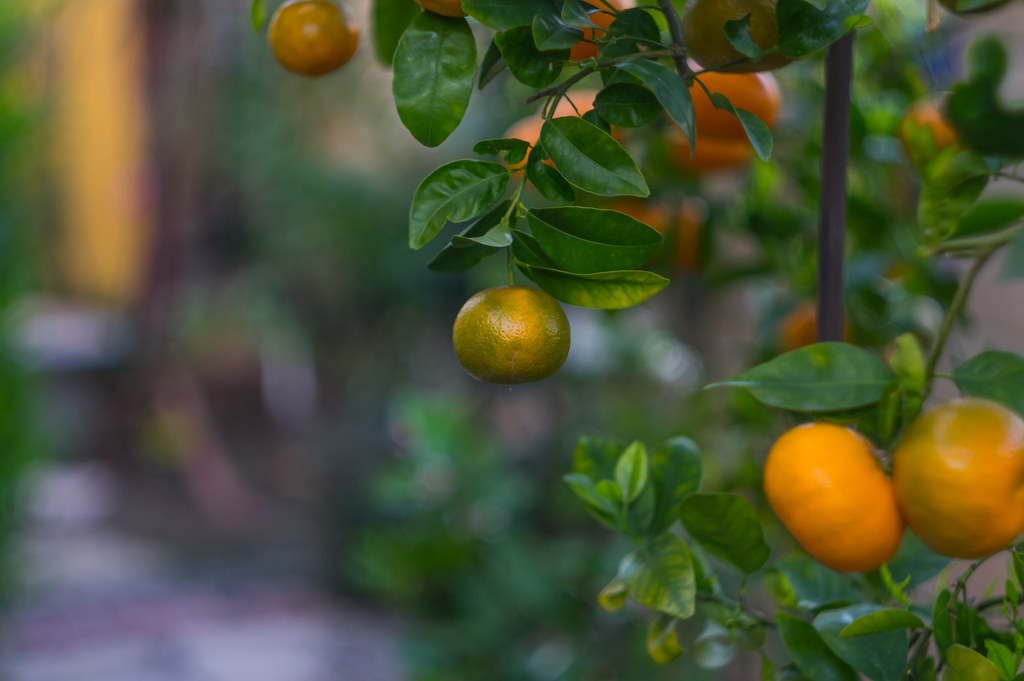 CZeissJenaBiotar58mmf2-K3-UnaMandarina1 by Palenquero Photography, on Flickr CZeissJenaBiotar58mmf2-K3-UnaMandarina1 by Palenquero Photography, on Flickr
 Wide Open by Palenquero Photography, on Flickr Wide Open by Palenquero Photography, on Flickr
 CZeissJenaBiotar58mmf2-K3-PeachBloss by Palenquero Photography, on Flickr CZeissJenaBiotar58mmf2-K3-PeachBloss by Palenquero Photography, on Flickr
For comparison, I have included a shot taken with the Helios 44-3:
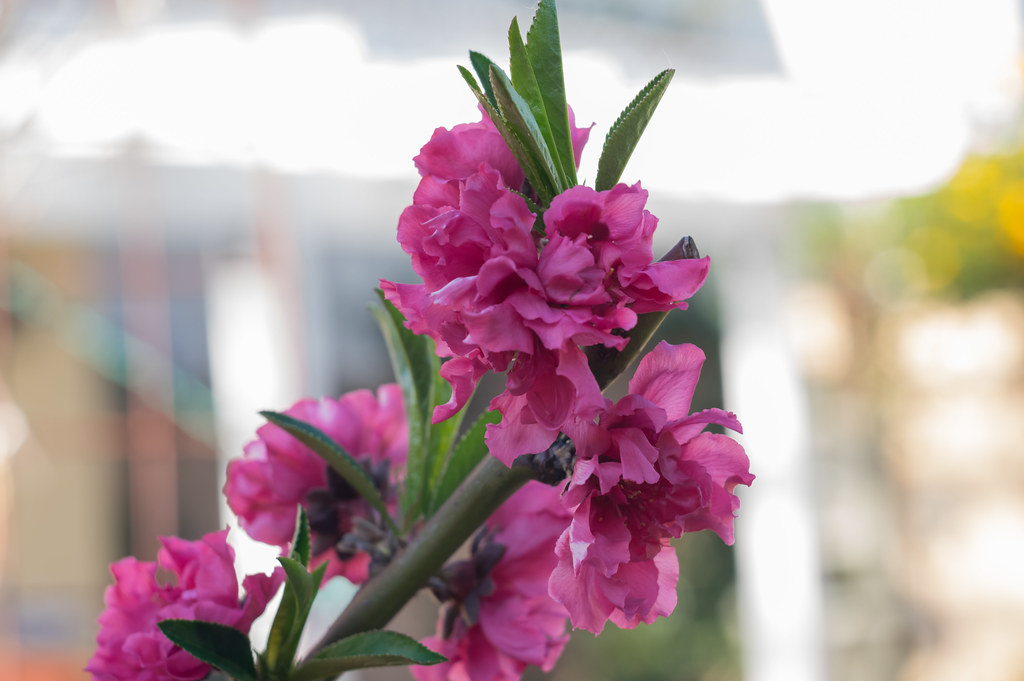 Peach Blossom by Palenquero Photography, on Flickr Peach Blossom by Palenquero Photography, on Flickr
| | | | | Pentaxian Registered: July, 2012 Posts: 928
4 users found this helpful
| | Review Date: March 16, 2015 | Recommended | Price: $150.00
| Rating: 8 |
| Pros: | Small, sharp, 17 blades for exceptional bokeh | | Cons: | Sticky focusing ring, colours, 0.9m MFD, expensive, hard to find one without air bubbles or scratched glass | | Sharpness: 10
Aberrations: 8
Bokeh: 10
Handling: 6
Value: 7
Camera Used: K-3
| |
Carl Zeiss Jena Biotar, 58/2, 17 blades
This review is for a 17-bladed, M42 screw-mount, black Biotar T, manufactured around 1950, according to this list of serial numbers. http://forum.mflenses.com/carl-zeiss-jena-lenses-issue-date-by-serial-number-t6865.html. It has a MFD of 0.9m. Most Biotar 58/2's have 10 blades, or sometimes 13 blades, and most have a MFD of 0.5m.
A photo of the lens and its "sons", a Helios 44-2 and Helios 44 zebra is shown below. As you can see, the Biotar is considerably smaller - quite a surprise when it arrived. It has a preset (no stops) aperture ring at the front that opens and closes all those tiny little blades in the most exquisite manner. Less good is the focus ring. It's tough to turn, but I was expecting this - it's a common problem of the lubricant used, apparently. Sometimes, I've unscrewed the lens from its adaptor trying to change the focal length.
An 'expected surprise': air bubbles in the glass. If you worry about dust inside your lens, then these bubbles may tip you over the edge. Equally, given the old age of these versions, its normal to find the front glass has scratches....certainly the fifty or so lenses for sale I looked at before buying mine had at least a few micro scratches, and sometimes loads of scratches. However, neither the bubbles nor small scratches appear to show on the images taken by the lens. Just think of the bubbles as a sign of exceptionally high quality glass. 
Optically, the lens is a gem. It is reasonably sharp wide open and very sharp stopped down. Contrary to some reports of swirly bokeh, my lens does not produce swirly bokeh like the 8-bladed Helios 44-2. It does swirl a bit in the right conditions, but not as much as the Helios. The beauty of 17-blades, of course, is that the oof rendering stopped down is really excellent, without bokehgones. For longer-distance photos, the Biotar is infinitely better than my Helios 44-2. It's interesting to see the original bakelite hood - it's impressive/large, and the lens benefits from a hood.
Colour rendition is quite muted, like the Helios. But once off the camera, the images can be PP'd easily to boost colour vibrancy. While the 0.9m minimum focus distance is not great (versus 0.5m for later Biotars/Helios; the difference is really noticeable), the lens works very well with extension tubes for closer focusing. Focusing the Biotar is challenging beyond (say) f5.6; the viewfinder image goes quite dark/cloudy. However, the aperture ring is so smooth, I simply focus wide open and then close down.
Would I recommend this particular version? A qualified yes. If you are a collector or big fan of Zeiss, or you just happen to want a lens with such a fabulous collection of blades (that's me!), then yes. It's a fine lens. If you like using your Helios 44-2, and are just curious to find out what the real deal is like....then I wouldn't bother. There's no need to buy the Zeiss, unless you have money to burn. I was very lucky to find a good copy at $150 at the end of 2014; they seem to go for around $250 (2014/5). The lesser-bladed versions are cheaper, but I have no idea how they compare. The Helios 44-2 is a remarkable lens, with extra swirls, for a fraction of that price. But....it's not nearly so sexy as the Biotar! I for one, am a proud owner of this famous lens.
I've posted some more photos from/of the lens here: https://www.flickr.com/photos/95859572@N06/sets/72157649510390487/
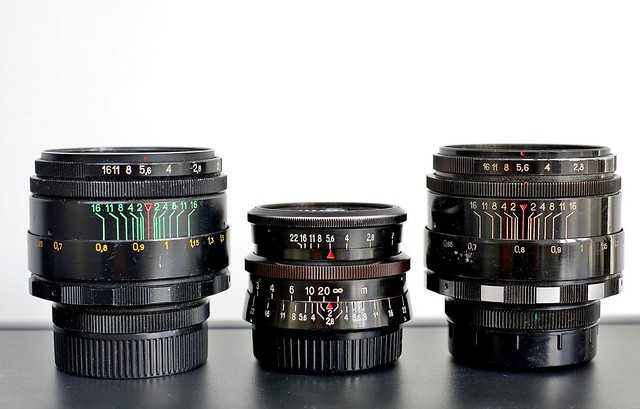
Biotar air bubbles

Smoothy bokeh

Sharp and vibrant when processed...
 | | | | | | | Senior Member Registered: December, 2009 Location: East Yorkshire Posts: 120 | | Review Date: June 11, 2010 | Recommended | Price: None indicated
| Rating: 8 |
| Pros: | Surprisingly good for its age. Great nostalgia value. | | Cons: | Lens flare, stiff focusing due to age. | |
I have this lens with a Pentacon FM that I inherited from a relative who purchased it in 1957. I have never used it on digital but have obtained consistently good results with film.
It is much slower to use than lenses that appeared just a few years later. This is not a bad thing as it makes you consider your shots more. A surprisingly sharp lens and is good even wide open. Some people may think it produces images that are a bit too cold as compared to modern lenses. It does suffer from lens flare that I put down to the early lens coatings not being that good, but this is solved to the greater extent by a lens hood. My copy is now a bit stiff to focus, but then again it is over 50 years old.
To really appreciate this lens use it on a 1950's Pentacon camera, all the controls are a little bit odd and nothing is automatic and this lens makes perfect sense. When this lens was made East Germany was still making serious photographic equipment and not the cheap and cheerful stuff made in the 70,s and 80,s that were all about getting hold of foreign exchange to prop up a failing economy.
| | | | | Veteran Member Registered: April, 2008 Location: Berlin, Germany Posts: 1,386
6 users found this helpful
| | Review Date: July 10, 2009 | Recommended | Price: $50.00
| Rating: 8 |
| Pros: | History in hand, good build, full open usability, portraits | | Cons: | Age can lead to stiff focus, subdued cool colors out of the box | |
Used on cameras: Pentax K100D (APS-C 6MPix)
Similar lenses used: SMC Takumar 1.8/55, Helios 44M-2..7
This lens is a classic design which has prevailed til today in f/2 55/58mm designs. It is said to have been copied in the soviet Helios 44xxx series lens.
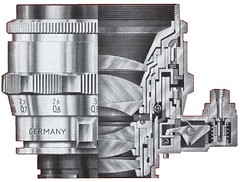
This is most probably the exact lens scheme of the reviewed lens (here in Exakta-mount)
My copy is the same as the above-pictured Biotar, 1Q with a red T and serial 4xxx (that makes it a 1956 model according to Rick Oleson). The Biotar will give you good resolution right from f/2. The bokeh is neutral imo and quite pleasing.
Like with so many lenses from that era, the Biotar will bring out colors in a subdued and cool way. That is to say, you will not get eye-popping colors out of the box. However, those colors are still there and there are some ways to bring them out like you want to. I have ended up with a good-quality Skylight 1B (warming UV) filter which stays put on the lens no matter what (would take it off in low light though). This will bring you the color shift you would apply in PostProcess most of the time. There is the possibility that such a filter enhances contrast also (given different contrast performances through the color spectrum). One more pre-PP method of giving the lens more pop is to expose to the right as far as possible. That's to say by trying to end up with a bright (but not blown-out) picture, you can easily apply some shades in PP and there's your extra pop without too much grain. That way I have gotten real good results from that lens on a K100D.
Although I did not shoot portraits with this particular lens, I assume that it is a good portrait lens. I derive this from my experiences with the Helios 44xxxx series lenses. Here we have the obvious comparison lens for the Biotar, the various copies from different factories in the former soviet union.
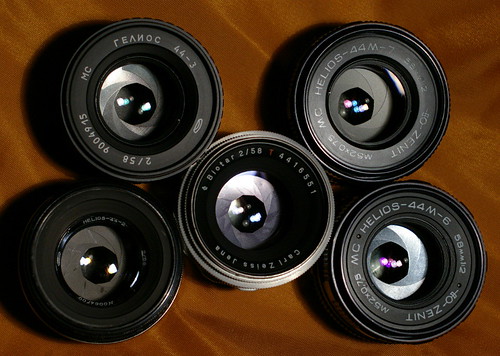
Different models and factory logos: Mother Biotar and her soviet daughters (all @f/4)
I would say that those lenses behave quite similar. Obviously you have coating differences and also a different number of aperture blades (there is even another Biotar version with even more blades). Other than that, I'd say you will get a good portrait lens with any of them.
Regarding macro capibilities I just am not competent enough to judge this lens. Given the 0.5m min. focus it seems not to be a dedicated macro though. In terms of sample variation there could be more variation with the soviet lenses. I have seen yet one other Biotar, which had the same optical quality imo and I would expect little copy variation in the original Biotar (see below chapters for more).
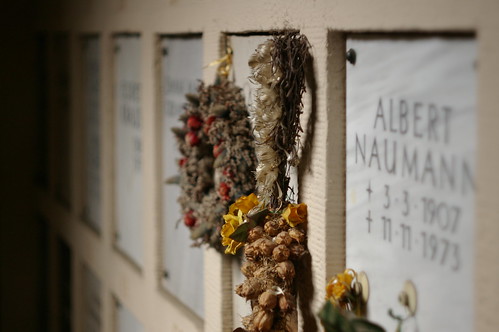
CZJ Biotar at f/2 no crop no PP on K100D + Skylight 1B filter
Mechanics: My reviewed sample has a smooth focussing ring all through the focus range and a very easy to turn aperture. This is absolutely amazing given the 50+ years of its life. However, I have seen another sample of the Biotar from the same age (a little younger even), which showed some more of what you'd expect from such an ancient lens, such as a hard turning focussing ring. Disassembly seems quite difficult. I still have a disass. PDF which I partly translated for a german guy who disassembled the Biotar. He was really scared, it's got a double helicoid and you'd better know how it came apart to have a chance to get it back working. Using the lens via adapter on the PK-mount was easy, it sits a tad over the adapters' diameter and will lock by screwing firmly onto the cameras bayonet flange. Nice. Apart from all that you are still getting an all-metal precision instrument from the post-war Zeiss factory.
Optics: That second sample of the Biotar also did not have the red 'T' marking on it (which would be the original Zeiss Tessar coating), however the coating looked exactly like the other '1Q' red 'T' sample, a blueish coating front and back. This partly explains the cool colors this lens will deliver. Both samples I have seen did not have dust in them, nor any signs of element separation or fungus. The Biotar does not have an infrared marking on the lens scale.
Handling: This is one of the reasons why many people feel attracted to the lens and rejected at the same time. The look and feel is obviously from another era. Focussing should be smooth but can be a little hard on your lens copy. It could be that by using it for some time, the focus will become smoother (specially in warmer climate). The focus throw is nearly one full turn, which makes for good finefocussing. The aperture is the classic preset aperture. A pull-and-turn ring sits below the aperture scale and you preset the aperture with that ring. Once done, you will have a stepless open-close aperture via turning that front ring to the preset aperture value. This is not too bad, you are getting a multi-blade aperture that is always working properly.
Exposure variations: This lens does not touch the camera contacts on the K100D. It will take 1.7 to 2.0 +EV to get good exposures (incl. the Skylight 1B filter). As 2.0 is already the maximum possible on the K100D, owners of cameras with a greater EV-latitude might have more possibilities to get the right exposure in any conditions.
Rating/score: I'd give this lens an 8 rating for optical performance. Given the limitations of the age of this lens, you have a real good chance to have some fun with it. Using it with the mentioned Skylight 1B filter and a decent lenshood you have an all-purpose lens with good portrait capabilities. I have found this lens to be really usable at f/2 also. I did not weigh into the score the climbing market price and obvious mechanical problems from a 50 year old lens which do not necessarily occur.
Conclusion: Great nostalghia lens and probably my very best 'white metal' lens of that era. The obvious question is whether this lens is worth the extra money compared to the Helios44xxx models. As far as I have seen, the Biotar might indeed be a tad better at full open - other than that any of those Helios lenses will probably be just as good as the Biotar, excluding soviet copy variation in the different models and factories.
General info:
https://www.pentaxforums.com/forums/pentax-slr-lens-discussion/53228-czj-biot...m-f-2-0-a.html
http://m42.artlimited.net/lens_detail.php?lid=35
http://www.taunusreiter.de/Cameras/Biotar.html
http://keppler.popphoto.com/blog/2007/04/inside_straight.html
http://www.flickr.com/photos/alf_sigaro/520159105/
http://www.zenitcamera.com/archive/lenses/helios-44.html
Pictures from this lens:
http://www.flickr.com/search/?q=biotar%2058
http://www.flickr.com/photos/yoyo31/sets/72157607809674354/
Best, Georg (the other)
| | | | | Veteran Member Registered: October, 2010 Location: Hong Kong Posts: 327 | | Review Date: March 20, 2012 | Not Recommended | Price: $25.00
| Rating: 7 |
| Pros: | owning a piece of history | | Cons: | colours, many other alternatives out there | |
interesting lens, i had no idea what i purchased as it was so cheap and random, but regardless i found the sharpness not bad overall, colours were not very appealing to me as it seems kind of cold (may appeal to others)
obviously there are more modern designs out there and faster 50's but hey if you get it for a cheap price it might look good on your mantlepiece
had a play with it a few times only but really in terms of practicality, speed and colors there are many other 50's out there
my recommendation is "no" based on this fact, but if you find one for a cheap price and have lots of time you might consider it, otherwise it just looks like an interesting lens on a mantlepiece
| | |






























